Saturday, September 26, 2015
Mini Cooper S (F56)
We’re unashamed MINI fans here at AUSmotive, especially the warmer versions. However, during the development of the F56 we became concerned that BMW was beginning to strip too much of the character away from the brand which has captured the imagination of hot hatch fans around the world since its relaunch in 2001.
BMW’s first attempt at a Cooper S, the R53, was in some ways its best effort. Sure there were build quality issues and its unsophisticated engine wouldn’t have looked out of place in a piece of farm machinery, but such things were offset by the car’s unmistakable charisma. The R53’s best traits were its just right retro styling, pinpoint handling and razor sharp steering. That it was all capped off by an endearing chorus belted out by the supercharger was the icing on the cake.
The car which followed, the R56, was undoubtedly an improvement in virtually all aspects. Yet, while it still left you with a broad smile, some of the cheekiness from the R53 had been lost. So what of the third attempt, the F56? Has BMW been able to integrate MINI more closely with the BMW family and still keep its sense of fun and noted go kart feel?
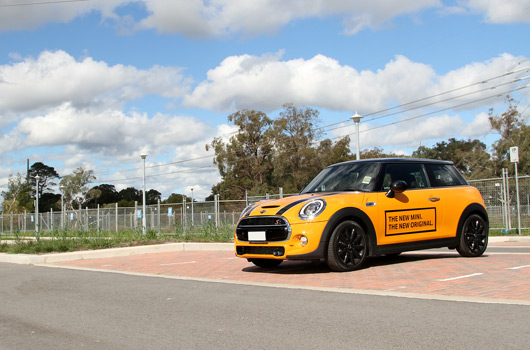
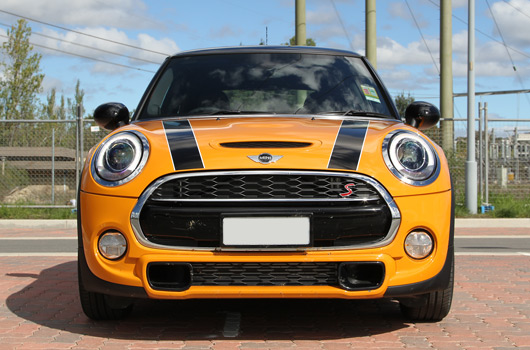
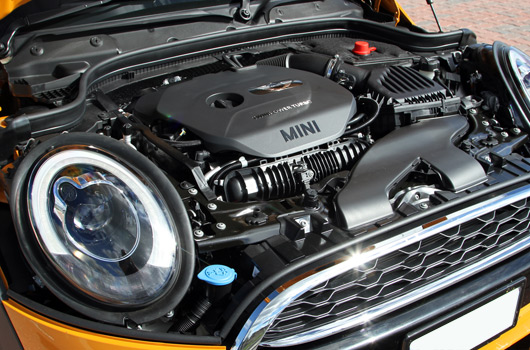
Now powered by a 2.0 litre four cylinder turbo—sourced from the Munich parts bin—and built on the UKL1 platform used for smaller BMW models, the MINI is no longer a stand alone brand smiled upon from above. The latest MINI is now a BMW in all but badging.
When you look at the F56 in pictures, sadly, it’s easy to find fault. The front end of the Cooper S, especially, is the least successful aspect of the F56’s take on MINI’s retro theme. It’s more functional than the R53 ever was, in that its crash protection is improved and the bona fide brake cooling ducts make the clunky design a little easier to take. However, with a quick glance alongside the R56 you may need to do a double take to spot the difference. The new car is bigger but the proportions have been well handled and despite some weak points this still looks like a MINI.
BMW’s stamp is most noticeable inside the cabin. That’s great when you consider the quality of materials used; it’s soon clear the F56 is easily the most well appointed and best put together MINI to date. Alas, with that comes a more homogenous visual language that is unmistakably BMW.
Okay, the central circular console and other features immediately say MINI, but the styling of the driver’s instruments on the steering column is BMW giving the world another pointless example of a square peg not fitting in a round hole. The look just isn’t right and the more time you spend looking at the gimmicky and not terribly functional fuel gauge to the right of the speedometer the more you want to stick a needle in your eye to ease the pain.
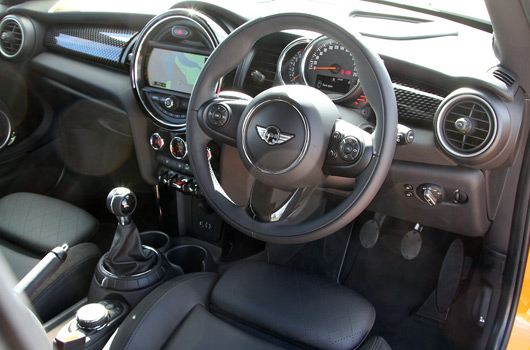
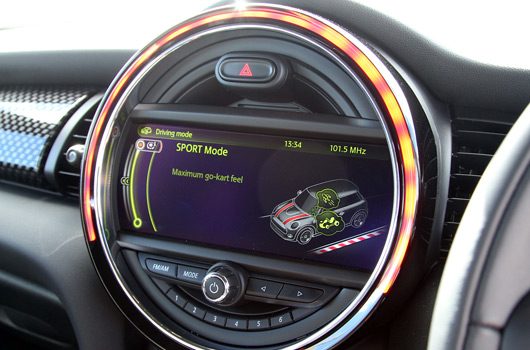
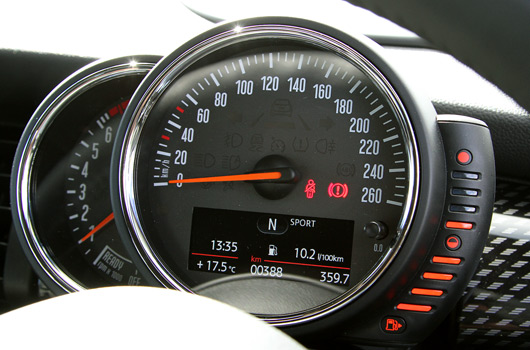
Reluctantly, though, when considering the overall result, we must report this is the best MINI we’ve sat inside. Thanks to F56’s larger dimensions the rear seat is not quite as laughable as it once was and the cargo space in the boot—known to R53 owners as the rear glovebox—is also better than previous models.
More than ever you feel cosseted inside the new MINI. The shoulder line seems higher and the dash higher too. Also, from inside the cabin, looking out the front quarter panels appear more pronounced and pointier than they look outside. It’s still a MINI, but different.
One last gripe on the interior and please forgive me, as this is both terribly pedantic and perhaps particular to those with a graphic design background such as your author here. All models now come with comfort access which means to start the car you must flick the bright red start switch in the centre console. And that’s when you see the horrors of the typography on said switch which has been set in Arial Condensed—a crap typeface at the best of times. MINI has its own font and its own visual style. Both have stood the test of time for over a decade now. Details like this shouldn’t be left to chance.
Of course, I’ll happily be put back in my place and ignore that detail if the driving experience is up to scratch.
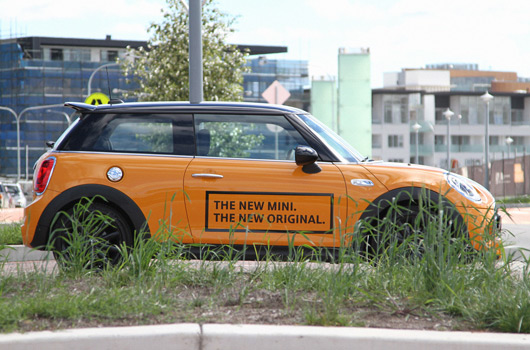
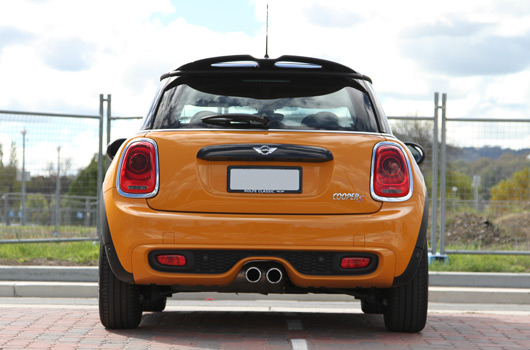
The first thing you notice about the F56 is just how well it rides on the road—this is the first Cooper S to be delivered standard without run flats. A mobility kit is all you have for a spare tyre and it’s no surprise to experience the improvement in the ride quality. Although, to place those improvements solely down to tyre choice would be to ignore the suspension, which soaks up bumps and undulations on the road with great dexterity and feel.
Absolutely precise steering feel is one thing BMW has been unable to match since the R53 delivered class leading feel and accuracy. The F56 is much like the R56, the steering is still very good, but due to its electronic nature there is a woodenness to it, especially at lower speeds where you could almost mistake it for torque steer such are the vagaries just off centre. Although, compared with other similar electronic steering applications from other brands we can’t really fault MINI more than anyone else in this regard. And, thankfully, when you start to drive the F56 Cooper S with greater purpose the steering weights up nicely and you soon forget that lack of feel from lower speeds.
Indeed, in almost all circumstances, wherever you point the steering wheel the MINI will follow. The only caveat there being the usual comment with front-wheel drives regarding understeer. The F56 is pretty neutral, though, and understeer is only found when pushing to the absolute limit.
The gear shift in from the 6-speed manual in the F56 is good and moving through the gears is mostly straightforward. Although, at times it doesn’t feel as precise as previous models and for the first time in a MINI that I can recall I missed a gear once or twice. Pedal placement is ideal and it’s easy to heel and toe. Although, there’s no need to that if you choose not to. When the car is in Sport mode it will automatically blip the throttle on downshifts. Aside from the fact it takes away some of the enjoyment of driving it’s both pretty cool and works quite well.
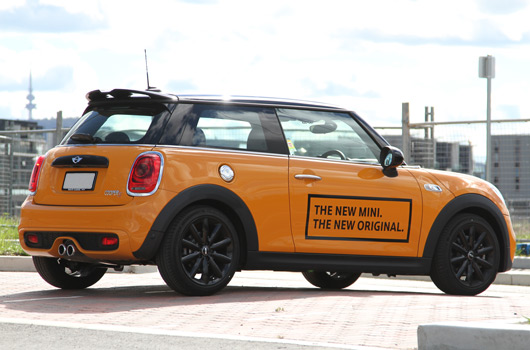
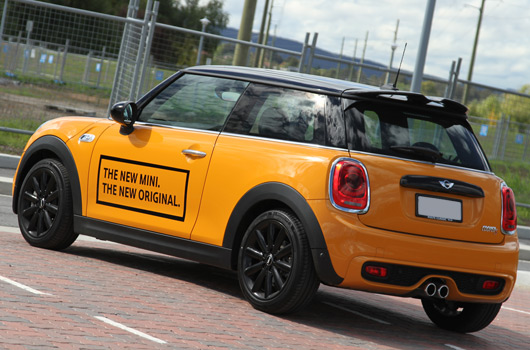
Pleasingly, and perhaps most importantly, you can throw the new Cooper S into a corner as aggressively as you ever could. Above all else driving a MINI should be fun and thankfully that most basic aspect of the brand’s DNA has not been lost. All corners are a friend of the MINI, though it’s through a series of esses where its chuckability is best enjoyed.
During braking the test car squirmed around quite a lot. I’m not sure if that is typical to all new F56 models or just the car I drove. No matter either way because it was actually a bit of fun. It was just being a cheeky little blighter keeping me on my toes! A timely reminder kids, always brake in a straight line. Certainly, once I was ready for a bit of looseness under braking I began to actively seek it out.
We know through its use in BMWs that the 2.0 litre turbocharged engine can produce a lot more power. The 141kW on offer in the Cooper S will probably be enough for most people, but there will be some of you out there who will want more, of course. You can count me in that category and I look forward to trying out the next-gen JCW when it arrives down under early next year. It will have at least 170kW to play with and there’s no reason to believe the chassis will flounder with the extra power.
Until the JCW rocks up though MINI has itself a very competent hot hatch on its hands. Through happenstance while testing the car I learnt the F56 can hold its own and more against a Mk7 Golf GTI. That may not bother your average MINI buyer though, who I suspect is less likely to cross shop whatever else is on offer. But it’s still good to know. Aside from a few minor styling gripes, which should not prevent ownership, the MINI is still a bucket load of fun to drive. As long as that remains the case I will always be a fan.
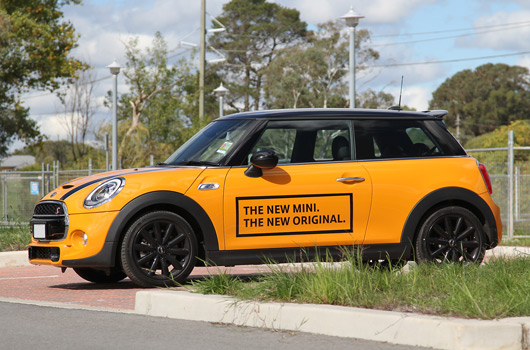
Editor’s note
As a side note perhaps some of the biggest competition to the Cooper S will come from the F56 Cooper. Powered by what some may consider to be an unfashionable 1.5 litre three cylinder engine—which doesn’t bring any significant power increase from the R56 Cooper—it is a remarkably capable car to drive. The addition of a turbo means the car has more torque and much better throttle response compared with previous models. Despite the literally odd cylinder layout the engine is smooth and we suspect the vast majority of Cooper owners won’t have any idea they’re driving an oddball three-pot.
No longer do you feel like you’re running with a tyre strapped around your waist, you feel free and easy to happily motor along whatever road you fancy. The Cooper still handles very well and the less fussy front end treatment looks better than the Cooper S too. An important point for the fashion conscious—hey, it is a MINI, right.
I liked the Cooper much more than I thought, even with its auto gearbox. I suspect a manual Cooper would be a barrel of laughs on a tight and twisty road. Underpowered, yes, but so much fun.
Okay, the Cooper is slower and noticeably so, but the performance gap to the Cooper S is as small as it have ever been. And with that the upsell proposition to attract a customer to the faster, and more expensive, Cooper S will become harder to close.
Labels:
Mini Cooper
Subscribe to:
Post Comments (Atom)


+-+Copy.jpg)






No comments:
Post a Comment